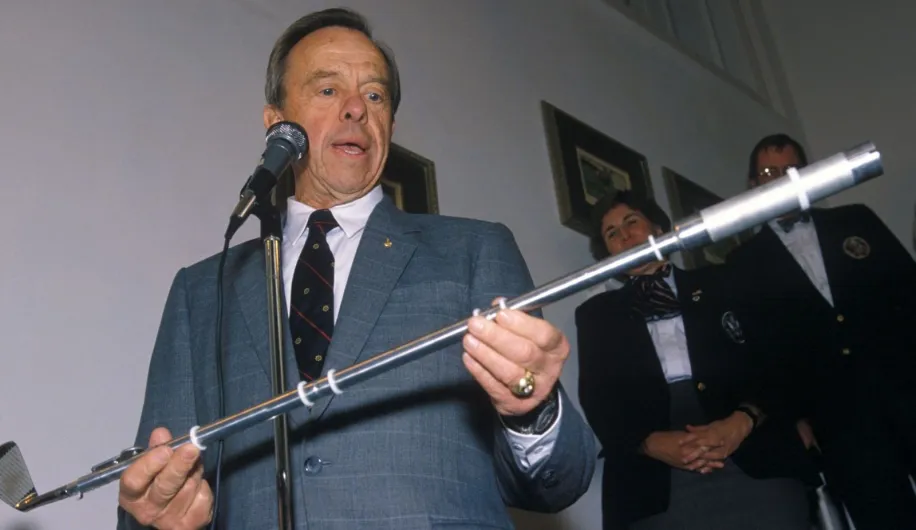Astronaut Alan Shepard's "Moon Shot" Celebrates 50th Anniversary

February 4, 2021 – Fifty years ago today, on Feb. 4, 1971, Commander Alan Shepard, as part of the Apollo 14 mission, hit the literal “moon” shot. Using a lunar excavator handle with the head of a six-iron attached to it, Shepard hit two golf balls off the surface of the moon.
While his first shot angled off into a crater, his second shot was up and away, all while Shepard was wearing a bulky spacesuit and backpack. Shepard said to the television audience back on earth that the second shot went “miles and miles and miles” in the gravity (or lack, thereof), which is measured to be one-sixth of the Earth. In reality, his shot likely traveled 200 yards to 400 yards.
That customized club, used for one of the most famous shots in the sport’s history, has resided at the USGA Museum in Far Hills, N.J., since Shepard donated it in 1974. A replica is housed at the Smithsonian National Air and Space Museum in Washington, D.C.
“Shepard came up with this idea and executed the whole feat. In his mind, he wanted to demonstrate the atmospheric and gravitational differences between the earth and the moon. He wanted a well-understood activity that the world would recognize, and a golf shot came to mind,” said USGA Senior Historian, Victoria Nenno.
“Everything is weighed very precisely when you are going into space. He brought along a retractable excavating device with a shaft made of aluminum and Teflon, with a scooper or claw on the end used to extricate moon dirt and rock sample. He knew he could detach the end, and attach the head of a golf club,” she said.
Shepard first thought of playing golf on the moon when he showed Bob Hope, a celebrity who loved golf, around the NASA facility. When Hope was hooked up to a moonwalker, he used an old driver for balance. Shepard saw the entertainer bouncing on his toes with the driver as support and was struck with the thought to hit a ball in outer space.
First, he needed a create a suitable “club” for the occasion. He measured out the shaft of the excavator as approximately the same as that of a six-iron. He then approached Jack Harden, the golf professional at River Oaks Country Club in Houston, to build the clubhead.
However, once the custom-made club was completed, golf wasn’t so easy, as Shepard found out, wearing his 200-pound space suit while trying to hit balls out of a bunker.
Only a handful of individuals knew that Shepard would attempt to play golf on the moon.
“He obviously didn’t want to break any rules. He received permission to do it from Bob Gilruth, the Director of NASA’s Manned Spacecraft Center,” Nenno stated.
“He knew it wouldn’t cost the taxpayers anything. Gilruth told him if everything had gone perfectly, then Shepard could execute his experiment at the end of the mission. It was contingent upon the success of the mission. It was one of the last things that they did before heading back to earth,” she said.
Said USGA Executive Producer of Content Mike Trostel in a 2013 article on atlasobscura.com: “When he got up there to the moon, he could barely get two hands on the club. The suit was so bulky.”
The full instrument with the clubhead and shaft weighs only 16.5 ounces, “So it is very light. He basically snuck two balls and a club head in a sock, and we also have the sock at Golf House,” Trostel said.
Shepard never revealed the brand of golf balls that he struck on the moon.
Another entertainer/golfer, Bing Crosby, Hope’s partner in several comedy films, suggested to Shepard in a letter that he consider donating the item to the USGA. Shepard agreed and was invited for years to play in Crosby’s famed Pro-Am in Pebble Beach, where Shepard eventually resided.
“I don’t know if he was surprised or not by the amount of attention the moon shot received, but this experiment was related to the American public. Golf had gone through a boom in the 1950s and ’60s. Alan Shepard correctly assessed that many people would connect with this, and he was so right,” Nenno said.
“People forget that it really was a dangerous mission, but this was a lighthearted moment.”
